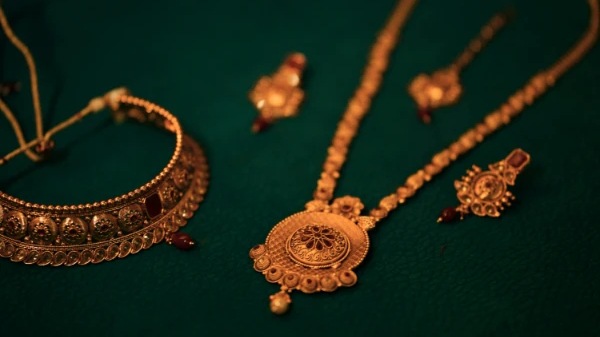Filigree gold is a delicate and intricate design technique used in jewelry manufacturing that involves twisting and curling fine gold wires to create ornate and lacy patterns. This art form has been used for centuries across many cultures, valued for its exquisite craftsmanship and the light, intricate designs that can be achieved with gold. Filigree work is often used to add elegance and complexity to various types of jewelry, including rings, earrings, necklaces, and bracelets. This article will explore the techniques of creating filigree gold, its different types, and its significance in the jewelry manufacturing process.
What is Filigree Gold?
Filigree gold refers to jewelry that has been decorated using fine threads or wires of gold, often combined into intricate, lace-like designs. This technique is labor-intensive, requiring a high level of skill and precision. Filigree work can be found in jewelry from many cultures, including Indian, Italian, and Middle Eastern traditions.
- Purpose: The primary purpose of filigree gold is to enhance the beauty and aesthetic appeal of a piece of jewelry by adding intricate details and elaborate patterns.
- Advantages: Filigree gold allows jewelers to create highly detailed and visually striking pieces without the need for large amounts of gold, making it both economical and artistic. It also provides a lightweight option for large jewelry pieces, as the designs often incorporate negative space.
Types of Filigree Gold
Openwork Filigree:
- Overview: Openwork filigree is characterized by its lace-like appearance, with intricate designs formed from twisted gold wires that are soldered together but left open, without a backing.
- Applications: This type of filigree is often used in earrings, pendants, and brooches to create delicate, lightweight designs.
Backed Filigree:
- Overview: In backed filigree, the intricate gold wire designs are soldered onto a flat sheet of gold or another metal. This provides structural support while maintaining the detailed appearance of the filigree.
- Applications: Backed filigree is used in rings and bracelets where additional durability is needed to withstand wear and tear.
Granulated Filigree:
- Overview: Granulated filigree incorporates small beads or granules of gold into the design, adding texture and visual interest to the piece.
- Applications: This type of filigree is used to add intricate details to larger jewelry pieces, such as statement necklaces or ceremonial jewelry.
Techniques for Creating Filigree Gold
Wire Drawing:
- Overview: The process of creating filigree begins with drawing gold into fine wires. This involves pulling gold through a series of progressively smaller holes until the desired wire thickness is achieved.
- Applications: The drawn wires are used to form the intricate patterns characteristic of filigree work.
Twisting and Shaping:
- Overview: Once the gold wires are prepared, they are twisted, curled, and shaped into intricate patterns. This step requires careful handcrafting to achieve the desired level of detail.
- Applications: Twisting and shaping are critical steps in forming the beautiful, lace-like designs that define filigree gold.
Soldering:
- Overview: After the patterns are formed, the gold wires are soldered together to hold the design in place. This is done with great precision to ensure that the delicate design remains intact.
- Applications: Soldering is used to join the wires together and to attach the filigree work to other components of the jewelry piece.
Importance of Filigree Gold in Jewelry Manufacturing
- Aesthetic Appeal: Filigree gold is renowned for its beauty and the level of detail that can be achieved. The delicate patterns created using fine gold wires add a touch of elegance and sophistication to any piece of jewelry.
- Cultural Significance: Filigree work has cultural significance in many parts of the world. It is often used in traditional jewelry that is worn for special occasions and ceremonies, adding both historical and cultural value to the pieces.
- Lightweight Design: Filigree gold is an excellent option for creating large, eye-catching jewelry pieces that are still lightweight and comfortable to wear. The intricate designs incorporate open spaces, which reduces the overall weight of the jewelry.
Practical Considerations for Filigree Gold
- Skill Level: Creating filigree gold requires a high level of skill and experience. The fine wires must be handled with precision, and even a small mistake can compromise the entire design.
- Durability: Filigree gold jewelry can be delicate and may be more prone to damage compared to solid gold pieces. Proper care is needed to prevent bending or breaking the intricate wires.
- Combination with Other Techniques: Filigree is often combined with other jewelry-making techniques, such as stone setting or enameling, to create unique and visually appealing designs. Jewelers must carefully plan these combinations to ensure the final piece is cohesive and structurally sound.
Filigree Gold in Jewelry Manufacturing Process
The process of incorporating filigree gold into jewelry manufacturing begins with the design phase, where the intricate patterns are planned out. The gold is then drawn into fine wires, which are twisted, shaped, and soldered to form the desired design. The filigree work can be used as the main feature of a jewelry piece or as an embellishment to enhance the overall design.
Once the filigree design is complete, it may be combined with other components, such as gemstones or enamel, to create a finished piece. The final steps involve cleaning and polishing the jewelry to bring out the shine of the gold and highlight the intricate details of the filigree work. The result is a piece of jewelry that showcases the skill and artistry of the jeweler while providing a beautiful and unique accessory.
Conclusion
Filigree gold is a timeless and exquisite technique in jewelry manufacturing that allows for the creation of intricate, lacy designs that are both elegant and visually captivating. Whether used as a focal point or as an embellishment, filigree adds a touch of sophistication and craftsmanship to any jewelry piece. By mastering the techniques of wire drawing, twisting, and soldering, jewelers can create stunning filigree designs that reflect both cultural heritage and modern aesthetics. Filigree gold remains a beloved element in jewelry design, valued for its delicate beauty and artistic appeal.



